From family dinners to business meetings, our daily lives would be quite different without a table. Though they are often overlooked and taken for granted, there exist a handful of tables that are distinguished not only by their impeccable workmanship, but also the fascinating tales they have to tell.
Whether your interest is piqued by the ingenious design, pre-historic origins or even macabre history, each of these five rare and important tables possesses a unique story just waiting to be shared.
Johnstone, Jupe & Co. Patent Expanding Table
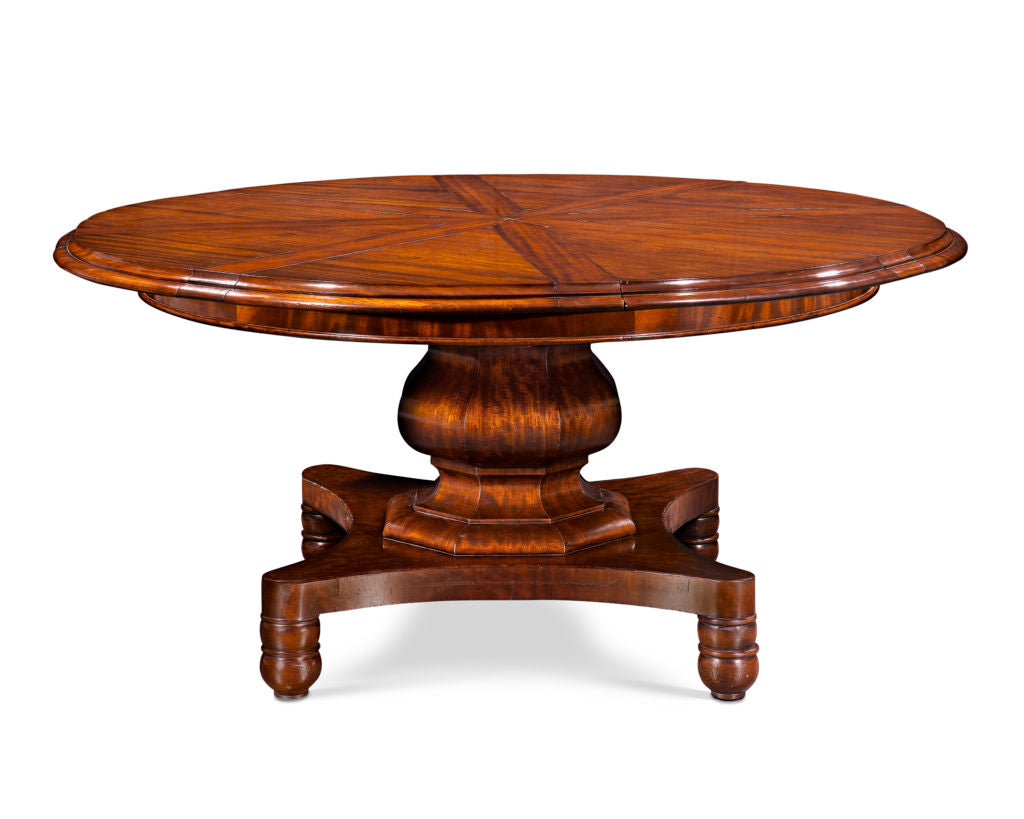
The Jupe Patent Expanding Table by Johnstone, Jupe & Co.
The 19th century proved to be a “golden age” of what became known as mechanical furniture. Marvels that blended the best aspects of mechanical engineering and cabinet making, these innovative furnishings were designed to serve multiple purposes, make life a little easier for the user while also eliminating the need for numerous furnishings cluttering the home and taking up space.
One such mechanical wonder came from a London upholsterer who had a novel idea for a round table that could expand to seat a varied number of guests, depending on the need.
Robert Jupe conceived the idea for his “expanding table” in the early 1830s. His design contained a capstan “swivel” mechanism that, when the dining table surface was turned, the sections that comprised the surface diverged from the center, making way for leaves that could effortlessly allow the table to transform from one for a small, intimate gathering into one well-suited for a large, formal dinner.

Brilliantly engineered, this Jupe expanding round table was created by the firm of Johnstone, Jupe & Co., circa 1835. This particular model has the ability to expand from roughly 54-inches to a larger 72-inch diameter. With a simple turn, this round table doubles its seating capacity from 6 guests to 12!
The first of these tables were created during his business partnership with fellow furniture craftsman John Johnstone and their firm of Johnstone, Jupe & Co. The partnership lasted for just five years, from 1835 to 1840, and the handful of known tables that bear the company's mark are among the rarest of all patented mechanical furniture and highly sought after.
Samuel Hawkins Exhibition Model Expanding Table

Samuel Hawkins' Exhibition Model Expanding Table. 13” high x 24” diameter as shown.
They say that great ideas are meant to be shared, or in this case, expanded upon. Inspired by Jupe's ingenuity, renowned English cabinetmaker Samuel Hawkins saw an opportunity to evolve Jupe's idea to create his own version of the expanding round table.
Hawkins devised a screw mechanism that pushed segments of the table outward using a crank system. When the crank lever was turned, the mechanism caused the outermost side of the table to fan out in order to accommodate semi-circular leaves that were added to the circumference of the table top. The beauty of Hawkins' design was that it could potentially be applied to both round and rectangular tables in the dining room.
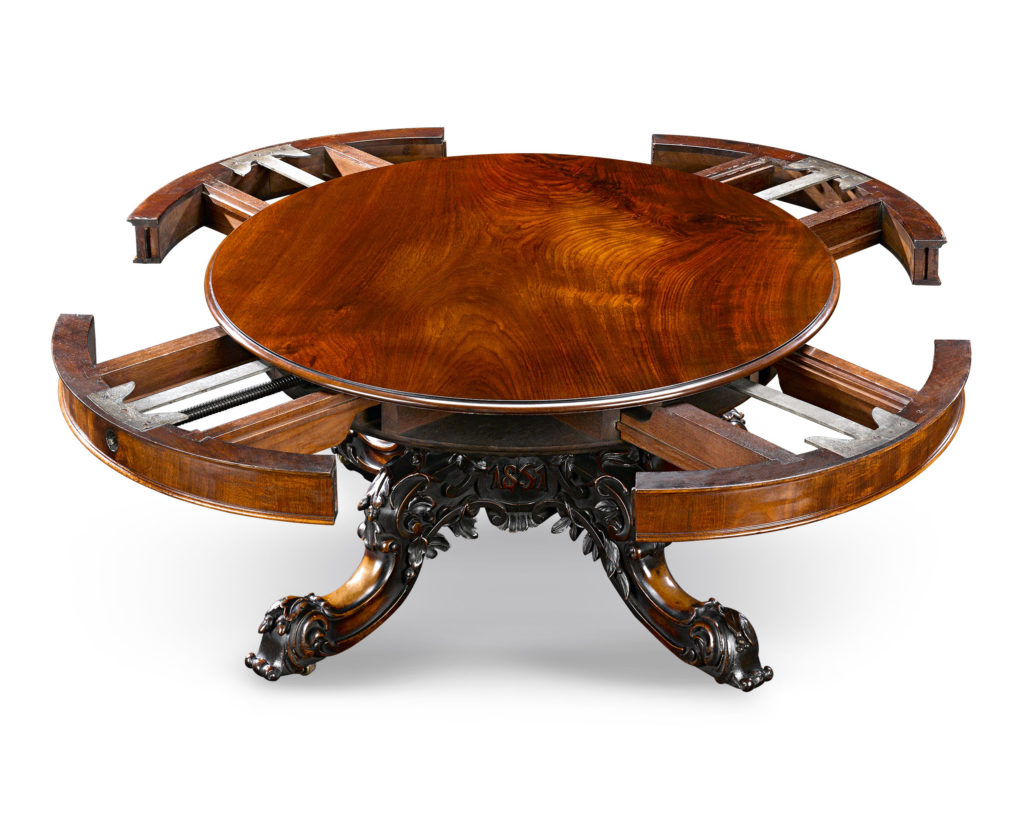
This one-of-a-kind exhibition model expanding round table was created by Samuel Hawkins for display at the Great Exhibition of 1851. Pieces such as this that were made specifically for this seminal exhibition are among the most valuable to be found, as they were crafted with the utmost attention to detail in order to make the very best, lasting impression upon critics and the millions of attendees alike.
Hawkins showcased his invention to the world at the most prestigious Great London Exhibition of 1851. In order to effectively and interactively display his concept to the world, he crafted this incredible mahogany model, especially for the exhibition. Even though it was a model, no detail was spared in its creation. Aesthetically, the table is stunning, featuring a majestically carved base that even features the year “1851” at the center of the four scrolling legs. The mechanical component works seamlessly in illustrating the craftsman's brilliance and workmanship.

Hawkins' table with all the leaves attached.
A century later, this model table was exhibited once again for the Festival of Britain held at the Victoria & Albert Museum in 1951. This model table is also featured in the official catalogs for this exhibition, plus the Great Exhibition of 1851.
George III Irish Wake Table

The Irish Wake Table.
Mortality has fascinated, and frightened, humanity since the beginning of time. And, as is the case with most life-cycle events, an entire set of rituals and customs evolved around death. Observed by many cultures around the world, the wake is the custom of keeping vigil over the body of the deceased from the moment of death until burial. The custom originated in antiquity when it was felt necessary to ensure that the person was indeed, dead.
In the Christian tradition, before the 20th century, wakes were held in the home of the deceased, instead of the more currently-prevalent venue of the funeral home. Ireland, in particular, has a very rich wake tradition, of which this remarkable table played a tremendous role.
Known as a “wake table” these large, beautiful Irish tables were skillfully constructed with folding side panels to display and support the coffin of the deceased before burial. Celtic tradition mandated that the body of the recently departed had to be watched constantly for various purported reasons. One origin states that the wake prevented the removal of the body and soul by evil spirits. Another reported reason was due to the once-common usage of pewter drinkware. The high level of lead would seep into the beverage and cause one to enter a cationic state that gave the appearance of death, with the affected person regaining consciousness after the passage of a few hours or even days!
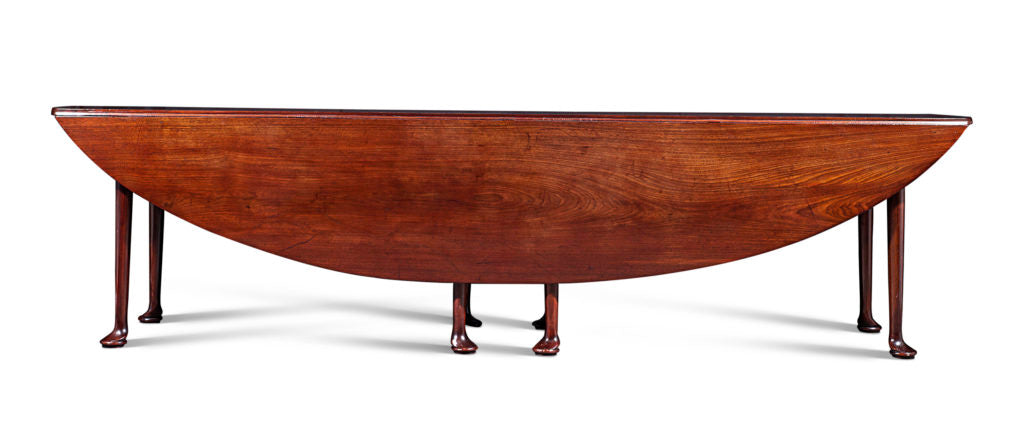
This intriguing and truly exceptional example of 19th-century Irish furniture is referred to as a “wake” table. With its folding side panels, these grand tables allowed for the view, display and support of the coffin and the deceased before burial. Today, these tables are highly sought-after as dining tables.
Regardless of the rationale, or the original macabre usage, today, these amazing tables are highly prized and sought after as dining tables. Their oval shape makes them perfect for social occasions since everyone seated at the table is within view. Wake tables, especially of this phenomenal size and quality, are rarely found outside of Ireland.
View our current Irish Furniture offerings
Regency Fossil and Burl Elm Pedestal Table

The Regency Fossil and Burl Elm Pedestal Table.
When we think of fossils, our minds automatically revert to the awe-inspiring reconstructed skeletons of the great Terrainasaurus Rex on display at the natural history museum, or the ravenous Velociraptor of Hollywood cinema fame, but certainly not an elegant piece of furniture, right?
This incredible Regency-period side table just so happens to blend the time-honored tradition of English furniture making with an exceptional relic of natural history. While the base is crafted entirely of skillfully worked elm highlighted by burl elm veneer of Sheraton design, the octagonal top is made of a monumental specimen of Turtlestone.

A giant pre-historic specimen of Turtlestone comprises the octagonal top of his incredible Regency-era side table. Taken from the Oxford Clay, this particular Turtlestone has an Ammonite fossil at its center, adding to the scarcity and importance of this amazing table.
Turtlestone is an English marble that is derived from fossilized spheres known as septarian nodules. These nodules are over 150 million years old and date to the Jurassic period, more popularly known as the age of dinosaurs. This particular specimen of Turtlestone is even more significant due to the embedded Ammonite fossil at its center. Though closely resembling an abalone in appearance, this now-extinct mollusk is from the scientific class Cephalopoda and more closely related to octopuses and squid. The Oxford Clay Formation from which this pre-historic relic originated stretches underneath much of southeast England and is famed for its abundant marine life fossil record.
At the time this amazing table was constructed, tremendous advancements in the earth sciences were unfolding that gave the public an unprecedented glimpse into the extensive history of our planet. Those in the educated, upper echelons of society collected relics of these innovative scientific discoveries. This Turtlestone was purchased and commissioned into this table by a masterful cabinetmaker in the early 19th century for an important English noble family. Today, due to the immense size of the specimen, it is believed to be the most important furnishing to incorporate this incredibly rare fossilized marble known to exist.
View our current Regency Furniture offerings
Pietre Dure Console Tables
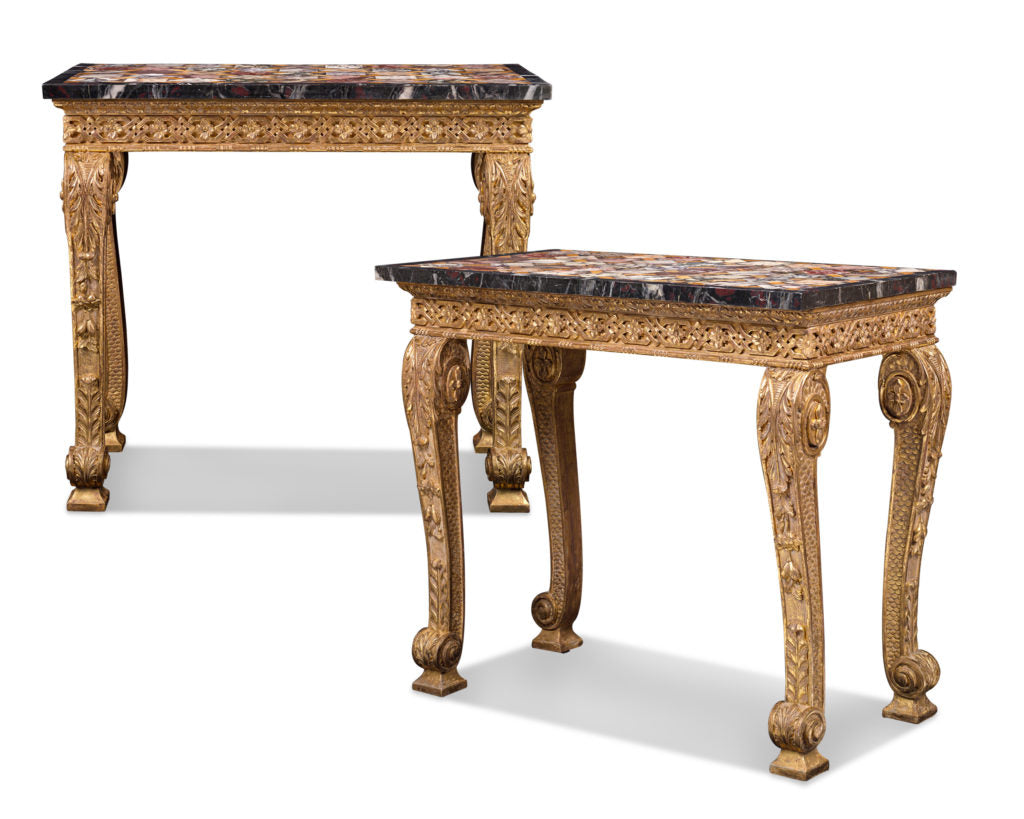
The Pietre Dure Console Tables.
For centuries, people around the world have harvested some of the most beautiful natural substances to make striking works of art. Everything from intricate personal adornments to grand architectural masterpieces has been crafted utilizing stones originating deep within the Earth's surface, including these Georgian Pietre Dure Console Tables hailing from a titled European estate.
Their incredible pietre dure marble specimen tops are aligned in a striking geometric latticework motif comprising some of the rarest marbles, including Breccia Medici, Siena, Breche Violette, Breccia Calicatta, Onyx Fiorito, Toscana, Breccia Siena, Breccia Nouvelle, African Red and Verdi di Caesar. Adding to the luxury of these tables are their intricately designed bases in the style of William Kent, the preeminent architect and designer of the early Georgian period. Their gilt surface is punctuated by fish scales, lattice and acanthus elements in the classical vein, culminating in furnishings of impeccable workmanship.
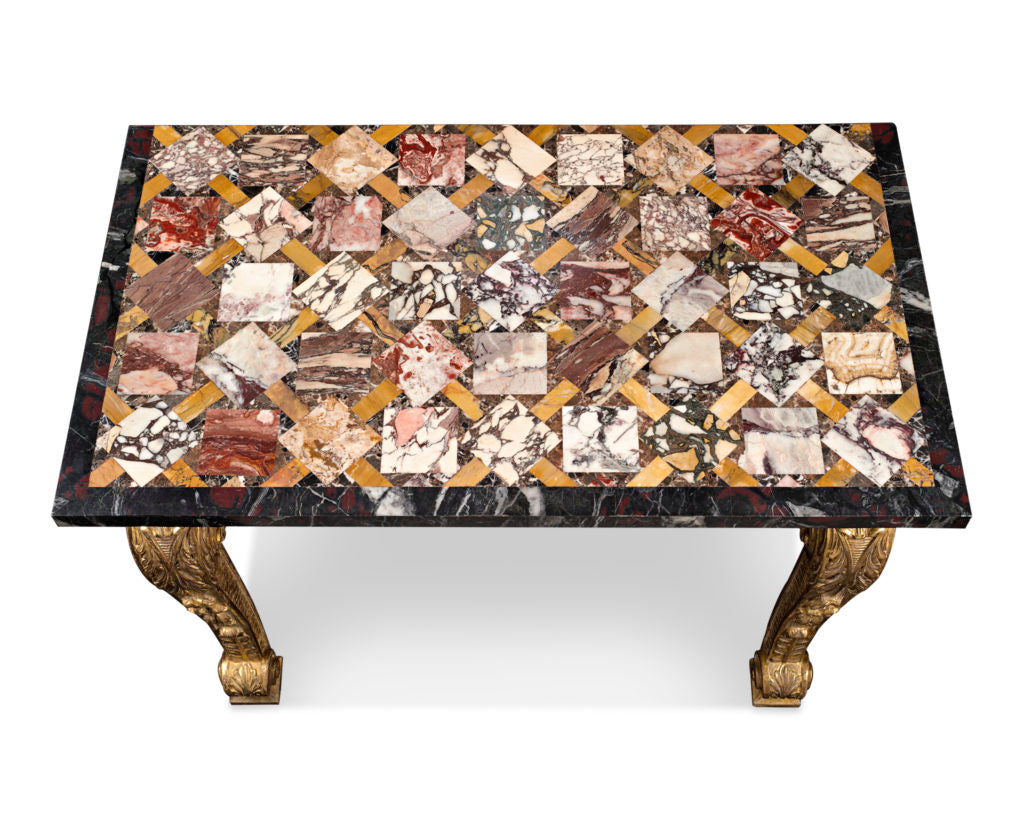
Pietre dure requires the utmost precision. The artist must cut the various stones to exacting measurements in order for each piece to fit perfectly and to create the desired effect.
With roots in 4th-century Rome, pietre dure is one of the oldest techniques in the decorative arts. With a meticulous eye and steady hand, a master of this hardstone inlay skill can literally “paint” a picture in stone. Precision is key when creating pietre dure. The artisan first selects only the finest specimens of marble, semi-precious and, in some cases, precious stones, to compose his work. Since these elements literally come in every color of the rainbow, the creative possibilities are truly endless. Once the artist has created his design on paper, the individual elements of the image must be delicately cut from the materials to exact proportions, as each must fit together perfectly, much like the pieces of a puzzle, to compose the final work of art.
Due to the expense of the technique, many faux “pietre dure” were in the completed in the 19th century using imitation marble and are today known as “scagliola”. True marble and stone pietre dure, such as the tops of these consoles, are very rare and were available only to the wealthiest Europeans tourists and Italian households.



